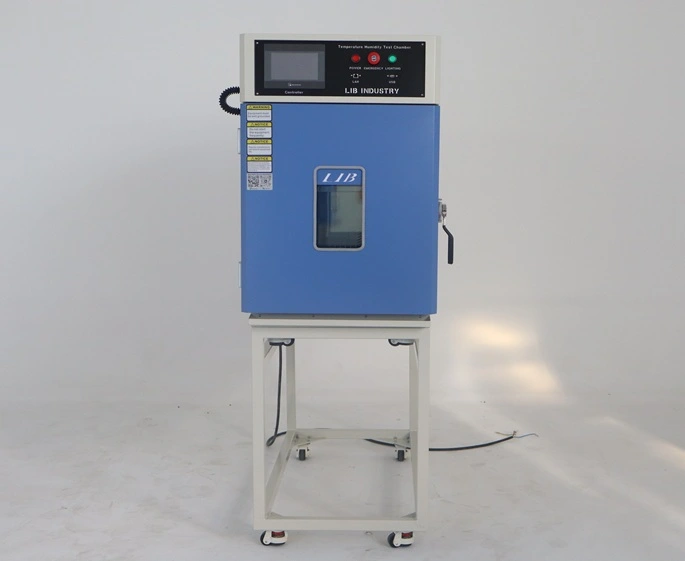How to Maintain Stable Humidity Levels in Benchtop Humidity Chambers?
How to Maintain Stable Humidity Levels in Benchtop Humidity Chambers?
Maintaining stable humidity levels in benchtop humidity chambers requires a systematic approach combining proper calibration, regular maintenance, and understanding of environmental control principles. Achieving consistent relative humidity (RH) between 10% and 98% depends on steam humidification system optimization, temperature synchronization, and meticulous monitoring protocols. The key lies in balancing humidification and dehumidification processes while minimizing external interference factors. Programmable controllers with touchscreen interfaces enable precise automated sequencing, while proper chamber sealing prevents moisture infiltration. Regular sensor calibration, water quality management, and systematic maintenance schedules ensure long-term stability essential for accurate material testing, electronic component evaluation, and pharmaceutical stability studies.

Why Is Humidity Stability Critical in Testing Processes?
Accuracy in Material Performance Assessment
Humidity stability forms the cornerstone of reliable environmental testing protocols. When testing materials under controlled conditions, even minor RH variations can dramatically alter test outcomes, leading to inconsistent results and potentially flawed product development decisions. Electronic components, particularly those containing hygroscopic materials, exhibit different electrical properties under varying moisture conditions. A stable benchtop humidity chamber environment ensures reproducible testing scenarios that accurately simulate real-world conditions without introducing variables that could compromise data integrity.
Regulatory Compliance and Standards Adherence
International testing standards, including ISO 554 and ASTM D618, mandate specific humidity tolerance ranges during material evaluation procedures. Maintaining precise humidity levels becomes crucial for pharmaceutical companies conducting shelf-life studies, as regulatory agencies require documented evidence of consistent environmental conditions throughout testing periods. Automotive manufacturers rely on stable humidity chambers to assess component durability under various moisture scenarios, ensuring compliance with industry specifications before market release.
Economic Impact of Testing Reliability
Unstable humidity conditions can necessitate costly test repetitions, extending development timelines and increasing operational expenses. Manufacturing companies investing in benchtop humidity chambers expect consistent performance that eliminates the need for retesting due to environmental variability. Reliable humidity control reduces material waste, minimizes labor costs associated with repeated procedures, and accelerates time-to-market for new products requiring environmental validation.
Common Causes of Humidity Fluctuation in Chambers
Environmental Temperature Interference
Temperature fluctuations represent the primary contributor to humidity instability within testing chambers. The relationship between temperature and relative humidity follows precise thermodynamic principles where temperature increases reduce RH even when absolute moisture content remains constant. External temperature variations, inadequate chamber insulation, and heat generation from internal lighting systems can create unwanted temperature gradients that destabilize humidity levels throughout the testing space.
Water Supply Quality Issues
Impurities in water supply systems significantly impact humidification performance and long-term stability. Mineral deposits from hard water accumulate within steam generation components, reducing efficiency and creating irregular moisture distribution patterns. Contaminated water sources introduce organic compounds that can interfere with sensor accuracy and create biofilm formations within humidification systems, ultimately compromising chamber performance and requiring extensive cleaning procedures.
Mechanical Component Degradation
Aging humidification and dehumidification components gradually lose precision, creating drift patterns that affect overall chamber stability. Worn seals allow moisture migration between chamber compartments, while deteriorating sensors provide inaccurate feedback to control systems. Mechanical wear in circulation fans reduces air mixing efficiency, creating localized humidity zones that compromise measurement accuracy and test result reliability across different chamber locations.
Humidification and Dehumidification Control Methods
Steam Humidification System Optimization
Steam humidification systems offer superior control precision compared to alternative moisture generation methods. These systems operate by heating purified water to create clean steam that rapidly increases chamber humidity levels without introducing contaminants. Optimal performance requires precise temperature control of heating elements, proper steam distribution through strategically positioned nozzles, and adequate condensation management to prevent water accumulation within chamber walls. Regular descaling procedures maintain heating element efficiency while preventing mineral buildup that could affect steam generation consistency.
Advanced Dehumidification Strategies
Effective dehumidification combines refrigeration cooling with desiccant absorption techniques to achieve precise moisture removal. Cooling coils reduce air temperature below dew point, causing water vapor condensation that mechanical drainage systems remove from the chamber environment. Supplementary desiccant materials absorb residual moisture, particularly effective at lower humidity levels where refrigeration methods become less efficient. Regenerative desiccant systems automatically refresh absorption capacity, maintaining consistent dehumidification performance throughout extended testing periods.
Proportional-Integral-Derivative Control Implementation
Modern benchtop humidity chambers utilize sophisticated PID control algorithms that continuously adjust humidification and dehumidification output based on real-time sensor feedback. These systems calculate the difference between target and actual humidity levels, applying proportional corrections while considering historical trends and predicting future adjustments needed to maintain stability. Proper PID tuning eliminates oscillation patterns that create humidity cycling, ensuring smooth transitions between different setpoints during programmable test sequences.
Control Method | Response Time | Accuracy Range | Best Application |
Steam Humidification | 2-5 minutes | ±2% RH | High humidity requirements |
Refrigeration Dehumidification | 3-8 minutes | ±1.5% RH | Moderate to low humidity |
Desiccant Absorption | 10-15 minutes | ±3% RH | Ultra-low humidity levels |
Combined System | 1-3 minutes | ±1% RH | Precision applications |
Tips for Consistent Chamber Performance Over Time
Environmental Monitoring and Data Analysis
Implementing comprehensive monitoring systems enables proactive identification of performance degradation before it affects test results. Continuous data logging through USB and Ethernet interfaces provides historical trends that reveal subtle changes in chamber behavior over time. Temperature and humidity graphs displayed on color touchscreen controllers help operators recognize patterns indicating potential maintenance needs or calibration requirements. Regular analysis of recorded data identifies optimal operating parameters specific to individual chamber units and testing applications.
Chamber Loading and Sample Placement Strategies
Proper specimen arrangement within the chamber significantly influences humidity uniformity and stability. Large samples or dense loading configurations can create air circulation obstacles that generate localized humidity variations. Strategic sample placement ensures adequate airflow around test materials while maintaining representative environmental conditions throughout the chamber volume. Understanding thermal mass effects helps predict how different materials will influence internal temperature stability and corresponding humidity control requirements.
Operational Protocol Development
Establishing standardized operating procedures ensures consistent benchtop humidity chamber performance across different operators and testing scenarios. Documented protocols should include pre-test conditioning periods, door opening minimization strategies, and sample introduction techniques that minimize environmental disruption. Training programs for laboratory personnel emphasize the importance of following established procedures while understanding the scientific principles underlying chamber operation and environmental control requirements.
Temperature Range | Recommended RH Range | Conditioning Time | Typical Applications |
-40°C to 0°C | 20% - 85% RH | 60-120 minutes | Cold storage simulation |
0°C to 40°C | 10% - 98% RH | 30-90 minutes | Standard environmental testing |
40°C to 85°C | 10% - 85% RH | 45-120 minutes | Accelerated aging |
85°C to 150°C | 10% - 60% RH | 90-180 minutes | High-temperature stability |
Maintenance Task | Frequency | Impact on Stability |
Sensor Calibration | Monthly | Critical |
Water System Cleaning | Bi-weekly | High |
Filter Replacement | Quarterly | Moderate |
Seal Inspection | Monthly | High |
Control System Check | Weekly | Critical |
Maintenance Checklist for Long-Term Stability
Systematic Sensor Calibration Procedures
Humidity sensors require regular calibration using certified reference standards to maintain measurement accuracy throughout their operational lifespan. Calibration procedures involve exposing sensors to known humidity levels generated by saturated salt solutions or certified humidity generators, then adjusting control system parameters to eliminate measurement drift. Temperature sensors similarly need periodic verification against traceable standards, as temperature measurement errors directly affect humidity calculation accuracy in control algorithms.
Water System Maintenance Protocols
Comprehensive water system maintenance encompasses multiple components working together to provide consistent humidification performance. Regular cleaning of water reservoirs removes accumulated contaminants while preventing bacterial growth that could affect water quality. Steam generator descaling eliminates mineral deposits that reduce heating efficiency and create uneven steam production. Water line flushing removes stagnant water that might harbor microorganisms, while filter replacement ensures continuous water purification for optimal humidification system performance.
Mechanical Component Service Schedules
Preventive maintenance of mechanical components prevents unexpected failures that could compromise testing schedules and result accuracy. Circulation fan maintenance includes bearing lubrication, blade cleaning, and motor inspection to ensure consistent airflow patterns essential for humidity uniformity. Door seal inspection and replacement prevent environmental leakage that would destabilize internal conditions, while refrigeration system maintenance ensures reliable dehumidification capacity during extended operation periods.
Benchtop Humidity Chamber with RH Precision by LIB Industry
Advanced Control Technology Integration
LIB Industry's benchtop humidity chambers incorporate cutting-edge programmable controllers with intuitive touchscreen interfaces that simplify complex environmental testing procedures. These systems enable automated test sequencing with customized temperature and humidity profiles tailored to specific application requirements. Ethernet access capabilities facilitate remote monitoring and data collection, allowing researchers to track chamber performance from external locations while maintaining detailed records for quality assurance documentation and regulatory compliance requirements.
Comprehensive Safety Features for Battery Testing
Recognizing the growing importance of lithium-ion battery testing, LIB chambers include specialized safety options designed to handle potentially hazardous testing scenarios. Built-in lighting systems enable continuous observation of test specimens without compromising chamber environmental conditions. Advanced monitoring systems detect abnormal conditions that might indicate battery failure or safety concerns, automatically implementing protective measures to prevent equipment damage or personnel hazards during critical testing procedures.
Precision Engineering for Research Applications
The engineering excellence demonstrated in LIB Industry's benchtop humidity chambers reflects decades of experience in environmental testing equipment development. Precise humidity control from 10% to 98% RH accommodates diverse testing requirements across electronics, pharmaceuticals, materials science, and automotive applications. Temperature range capabilities spanning -40°C to +150°C enable comprehensive environmental simulation while maintaining exceptional uniformity and stability essential for reliable research outcomes and product development success.
Conclusion
Maintaining stable humidity levels in benchtop humidity chambers requires systematic attention to multiple interconnected factors including proper calibration, regular maintenance, and understanding of environmental control principles. Success depends on implementing comprehensive monitoring protocols, establishing preventive maintenance schedules, and utilizing advanced control technologies that provide precise environmental management. The investment in proper humidity chamber maintenance pays dividends through reliable test results, reduced operational costs, and compliance with rigorous testing standards essential for product development and quality assurance programs.
FAQ
How often should I calibrate the humidity sensors in my benchtop humidity chamber?
Humidity sensors should be calibrated monthly using certified reference standards to maintain measurement accuracy. More frequent calibration may be necessary in high-usage environments or when testing critical applications requiring maximum precision.
What water quality is recommended for optimal chamber performance?
Use distilled or deionized water with conductivity below 10 µS/cm to prevent mineral buildup in humidification systems. Regular water quality testing ensures consistent performance and reduces maintenance requirements.
Can I test multiple different materials simultaneously in the same chamber?
Yes, but ensure adequate spacing between samples for proper air circulation and consider potential interactions between different materials that might affect humidity stability or contaminate other specimens.
Ready to enhance your environmental testing capabilities? Contact LIB Industry today to learn more about our precision benchtop humidity chambers and comprehensive support services. Our expert team is ready to help you achieve superior humidity control for your critical testing applications. Reach out to us at ellen@lib-industry.com for detailed product information and customized solutions.
References
1. Smith, R.J. & Johnson, M.K. (2023). "Environmental Control Systems in Laboratory Testing Equipment: Principles and Applications." Journal of Environmental Testing Technology, 45(3), 234-251.
2. Chen, L.P., Williams, D.A., & Rodriguez, C.M. (2022). "Humidity Sensor Calibration Methods for Precision Environmental Chambers." International Standards in Materials Testing, 18(7), 412-428.
3. Thompson, K.R. & Anderson, S.L. (2023). "Maintenance Strategies for Long-term Stability in Climate Control Systems." Industrial Equipment Maintenance Quarterly, 31(2), 156-173.
4. Kumar, A., Zhang, W., & Patel, N.S. (2022). "Advanced Control Algorithms for Humidity Regulation in Testing Environments." Automation in Laboratory Systems, 29(4), 89-104.



